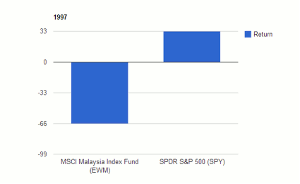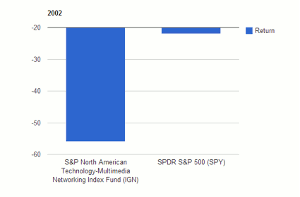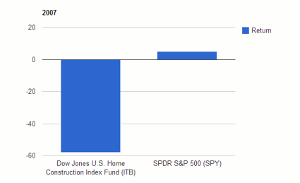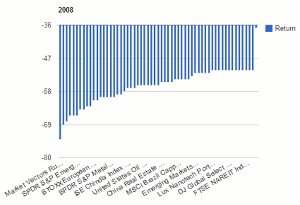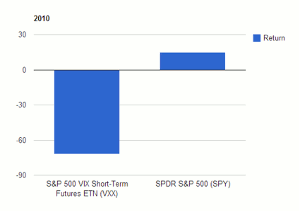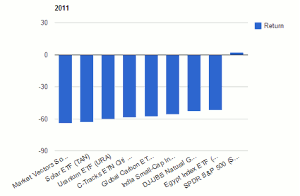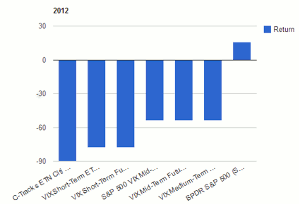As we approach the end of 2013, Jared Cummans of ETFdb.com takes a look back at the annual performance of every ETF to find some of the most notable losses in a single calendar year.
Since ETFs were introduced in 1993, the investing world has endured numerous recessions and a number of groundbreaking events that forever shifted how assets are allocated. While some years have seen markets prosper, others have watched them slip into a tailspin, dragging down various economies with them.
We took a look back at the annual performance of every ETF to find some of the most notable losses in a single calendar year, and the results may surprise you. Below, we display every fund that lost more than 50% in a single year, note that we excluded leveraged/inverse products from the list. All returns have been rounded to the nearest whole number.
1997: Malaysia Gets Hit Hard
Just one ETF endured a rough 1997, as the iShares MSCI Malaysia ETF (EWM) surrendered 67%. In a year when the Dow would break the 7,000 mark for the first time, and Steve Jobs returned to Apple, EWM suffered a major blow, as Malaysian equities fell into the doldrums. 1997 also happened to be the first full calendar year for this ETF, giving it quite an uphill battle out of the gate. Luckily, investors stood by the product, and it now holds more than $900 million in assets.
2002: Networking Stocks Plummet
Five years would pass until the ETF world saw another major casualty. The iShares North American Tech-Multimedia Networking ETF (IGN) lost 56% in 2002, its first full calendar year. Networking stocks like CSCO, JNPR, and MSI all had a rough go in 2002, dragging down IGN. Similar to EWM, investors kept their faith in the ETF, and it is now home to a quarter billion in total assets.
2007: The Housing Bubble Bursts
As the housing bubble began to show signs of weakness and begin its crippling downturn, it should come as no surprise to see the iShares US Home Construction ETF (ITB) shed 58% for the year. What is more surprising is that ITB is the only ETF that fell more than 50% that year; the SPDR Homebuilders ETF (XHB) fell just short of our benchmark with losses of 48% that year.
2008: The Great Recession
This list gets quite a shock in 2008, as the Great Recession slaughtered most investing classes. There were 58 funds that lost over 50% for the year, a number of which had debuted in 2007. What is perhaps the most surprising is how many foreign country ETFs made the list, as the recession infected global markets, leaving few unscathed.
2010: All Back to Normal
After a mostly positive 2009, just one fund had a downturn in 2010. In its first calendar year, the ultra-popular S&P 500 VIX Short-Term Futures ETN (VXX) sank 72% as markets continued to claw back the ground they lost in 2008. VXX is one of the most popular trading products on the market, and while it is not designed to be held for years at a time, it was certainly interesting to watch its movements as the market staged a massive recovery.
2011: A Mixed Bag
While it was not a record-breaking stretch by any means, 2011 was a relatively strong year for a number of investments. Still, there were a few laggards, as eight ETFs saw significant losses.
2012: Volatility Takes a Hit
Yet another strong year for the general market, and the only six funds to take a dive this year were all based on volatility indexes. Though there were a few bouts of volatility throughout 2012, as a whole, it was generally calm, forcing these funds to incur hefty losses.
From the bursting of the Internet bubble to the collapse of the housing market, ETFs have certainly seen their fair share of harsh times.
By Jared Cummans, Contributor, ETFdb.com

